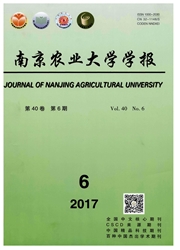

 中文摘要:
中文摘要:
[目的]光合作用对UV-B辐射增强的响应对评价粳稻在全球气候变化背景下的适应能力至关重要。本文旨在分析UV-B辐射增强对粳稻剑叶光合作用内在机制的影响。[方法]以北方粳稻品种‘沈农265’为试验材料,采用盆栽形式,试验设对照组CK(采用自然光照射),处理组T1、T2分别在自然光照基础上增加UV-B辐射1.05和2.1 W·m^-2,每个处理重复3或6次。选取粳稻幼苗移栽于无孔试验桶中,紫外灯照射时间为08:00—16:00,阴雨天不进行UV-B处理,直至成熟收获。试验期间对粳稻各生长时期进行剑叶活体测量,测定光合电子流传递分配、光合响应曲线及参数,包括非环式光合电子流中参与碳还原或光呼吸的那一部分电子流Jc、Jo,表观量子效率(AQY),最大净光合速率(P(max))和暗呼吸速率(Rd)的变化特征。[结果]对光合电子传递的影响:UV-B辐射增强在剑叶各个生长期Jc和Jo(非环式电子流中参与光呼吸和碳还原的电子流)均降低,Jo/JF与Jo/Jc(光呼吸所占的比例)均增加,说明UV-B增强降低了光合电子进入碳还原的部分;UV-B处理在剑叶各个生长期也降低了Vo(Rubisco的氧化速率)和Vc(Rubisco的羧化速率),但Vo/Vc呈上升趋势,且与UV-B辐射强度成正比,说明UV-B辐射增强降低了Rubisco(核酮糖-1,5-二磷酸加氧酶)的羧化速率。对光合响应特性的影响:剑叶各生长期在UV-B处理下,CK与T1、T2的光合响应曲线趋势相同,净光合速率(Pn)从大到小的处理为对照组、低剂量UV-B辐射、高剂量辐射;除成熟期,LSP(光饱和点)均降低,在灌浆期降幅最大,除灌浆期,LCP(光补偿点)均上升,在孕穗期升幅最大;AQY总体呈下降趋势;P(max)显著下降,T2对P(max)的抑制程度大于T1;除成熟期,Rd(暗呼吸速率)都呈增加趋势,灌浆期增幅最高。[结论]UV-B辐射增强总体上增加了剑叶光呼吸耗能,降低了光合电子
 英文摘要:
英文摘要:
[Objectives] Understanding how the photosynthesis would respond to the increased UV-B radiation is critical to evaluating the adaptability of rice under global change context. This paper aims to characterize the changes of these parameters of japonica rice when the UV-B radiation is enhanced.[Methods] In this study,the japonica varieties‘Shennong 265’was used and was exposed to either natural light(CK)or enhanced UV-B radiation. The treatments were set as T1 and T2 in which the UV-B radiation was increased by 1.05 and 2.1 W·m^-2 respectively,with each treatment repeated 3 or 6 times. Selecting the seedling transplant into the nonporous test barrel,UV-B radiation time is from 08:00 to 16:00,without in rainy days until the growth. We made the vivo measurements each period of flag leaf,depending on the measurement item:the photosynthetic electron transport and photosynthetic light response parameters,including Jc,Jo,apparent quantum yield(AQY),maximum photosynthesis rate(Pmax)and the daytime ecosystem respiration(Rd).[Results] When the UV-B radiation increased,the Jc and Jo of flag leaves decreased,while Jo/JF and Jo/Jc increased. This indicated that enhanced UV-B reduced the quantity of photosynthetic electrons which was used to get into the progress of carbon reduction. The UV-B radiation reduced the Vo and Vc,but increased Vo/Vc of the flag leaves in each growing period. It was positively related to the intensity of UV-B radiation which indicated that enhanced UV-B reduced the carboxylation rate of Rubisco. Generally,the increased UV-B radiation had no effects on the trends of light response curves. The LSP decreased because of the increased UV-B radiation in each growing stages except for maturation stage. In filling stage,the decrease amplitude reached its maximum. The LCP increased in each growing stages except for filling stage. The increase amplitude got to its maximum in booting stage. In addition,the AQY decreased. The Pmax decreased significantly and the inhibition effects of T2
 同期刊论文项目
同期刊论文项目
 同项目期刊论文
同项目期刊论文
 期刊信息
期刊信息
